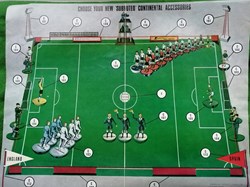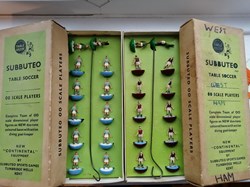Subbuteo Football
Subbuteo Football
When bad weather prevented us from playing outdoors, Keith and I would often play in my house. We enjoyed playing board games such as ‘Monopoly’ and ‘Escalado’ (a horse-racing game) but we mostly played Subbuteo table football, though we usually set the pitch out on the floor where we crawled on hands and knees to flick the playing figures with our fingers. I became obsessed with the game and spent hours playing alone because Keith was less interested than me and, since he didn’t have his own set to practice with, he usually lost to me, got disheartened and refused to play on.
The first Subbuteo set I got was ordered by post – I believe that I’d seen it advertised in a weekly football magazine, ‘Soccer Star’, which my parents bought for me. The first set arrived in a small cardboard box and consisted of cardboard footballer figures –one team in red shirts and the other in royal blue - which had to be glued into plastic bases to enable them to be flicked with fingers to strike a plastic ball. The goals were constructed of wire and plastic and paper goal nets had to be fixed to the goal frames. No playing pitch was provided but a set of instructions on how to mark out a pitch on an army-type blanket was included. My dad, as patient as ever, was able to set out a playing field by using chalk to draw the lines.
After some time, two sets of celluloid playing figures were bought for me – the cardboard figures had taken a battering and needed replacing! New goals with nets made of cotton thread were also bought. I didn’t receive ‘pocket money’ but comics and magazines were provided for me and, on shopping expeditions to Newcastle or Sunderland, I was allowed to select a ‘new’ team and bases at Stan Seymour’s sports shop or the Murton House Co-op in Newcastle, or Willie Watson’s sports shop in Sunderland. I built up a substantial collection of teams which I kept in empty ‘Sun-pat’ raisin boxes. I played the game well into my teens teaching my brothers how to play. Later, I taught my children the game and organised a Subbuteo Club whilst teaching at Donwell Primary School in Washington.
I probably spent as much time playing the game as youngsters today spend on electronic games. Subbuteo came to be played world-wide and there are serious collectors of teams and other accessories which the company developed. There are also tournaments in which exponents of the game can compete. I can never recall being bored – I read, drew and played Subbuteo if I wasn’t playing outdoors!
John Suggett 2021


